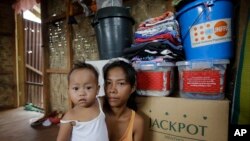In the most devastated areas of the central Philippines, where super typhoon Haiyan struck a blow at 14 million people last November 8, almost all of the debris is gone and utilities are back on. But there is still a shortage of housing and work.
The storm killed at least 6,000 people and displaced 4 million, after destroying or severely damaged an estimated 1.1 million homes.
The city of Tacloban suffered the greatest concentration of losses. Hidden away by tall grass near the water’s edge in Community 88 are about a dozen tent homes baking in the morning sun.
Gigi Clariza lives in one of them. She and her husband were fortunate they survived the storm while dozens of their neighbors perished, she said. But she remains uneasy.
"Who wouldn’t be afraid? Just a little wind and we come out and start looking around. We start thinking maybe there’s a storm again," she said. "That’s why we’re scared. We’d really like to be moved."
Clariza and her husband want to live farther inland, but they can’t afford it on their own. She said the government had told family members they would be notified when they would be moved away from the so-called danger zone. A year after the storm, they’re still waiting.
Chance for permanent housing
At the social welfare and development office in Tacloban, its head, Dr. Gloria Fabrigas, signs off on resident information cards that will be used in a lottery for 200 new houses. Community 88’s residents will be included in the next round.
"We still have a lot of families that still need to be placed in a permanent shelter," Fabrigas said, adding that another urgent need is for employment.
Fabrigas was on the front line moments after Haiyan swept through, bringing winds of up to 315 kilometers an hour and several tsunami-like storm surges. These decimated the shores near Tacloban and neighboring towns.
Tacloban’s mayor, Alfred Romualdez, is most concerned about 3,000 residents who need to be moved away from the water’s edge, deemed a "danger zone."
The city’s priority is to place 14,500 families in new permanent homes, he said. That will require doing studies, building the structures and making sure "utilities can sustain the project. … Not only for the present 14,500 houses that are going to be built but for even double that population later on."
Romualdez said planners are eyeing prime land on the city’s northern edge for the proposed annex. He admitted it may be wishful thinking to have it completed in three years. International aid agencies and the government would cover the costs and residents would not pay anything for the houses.
Charities help with shelter
Several major charities have their own plans to help people whose homes were destroyed. U.S.-based Catholic Relief Services, which has raised $56 million toward Haiyan relief and recovery efforts, is working on transitional housing. It involves either new construction or retrofitting existing structures to resist storms.
Joe Curry, who directs the agency’s operations in the Philippines, said an estimated 95,000 families live in substandard shelters right now.
"That’s a huge number of people to address," he said. "We at CRS have committed to building a total of 20,000 shelters to provide more long-term housing solutions for families and we just hope that the humanitarian community can address the balance."
Although the international community initially showed strong support for helping Haiyan’s victims, there are still "very serious needs on the ground," said Alison Kent, humanitarian policy adviser for Oxfam International.
The London-based charity just completed a needs assessment of the typhoon-affected area.
Haiyan hit a significant portion of the population already living in poverty, Kent said.
"We still see so many houses that have been repaired with debris from the storm — plastic sheeting, scraps of metal — because people just don’t have that basic level of income to repair their homes," she said. "And also, shelter assistance hasn’t reached all those households in need."
Building homes and employment
The Taiwan-based Tzu Chi Foundation, which has put close to $50 million into the hardest-hit areas, is taking a two-pronged approach to the lack of housing and jobs.
"For those who have no jobs, we’re engaging them in the installation of the [pre-fabricated] houses," said Alfred Li, who heads the organization’s Philippines office. "… We get them to do it so that they will have jobs."
Representatives for the humanitarian agencies say that despite difficulties, many residents are enthusiastically trying to rebuild their lives.
Tent dweller Clariza said she remains hopeful that she and her family will receive permanent housing and they "will have a normal life again."

